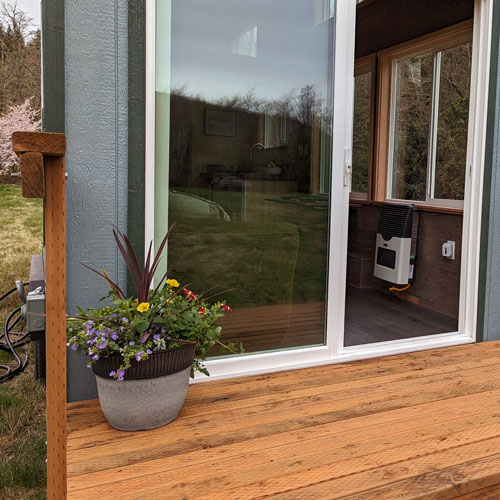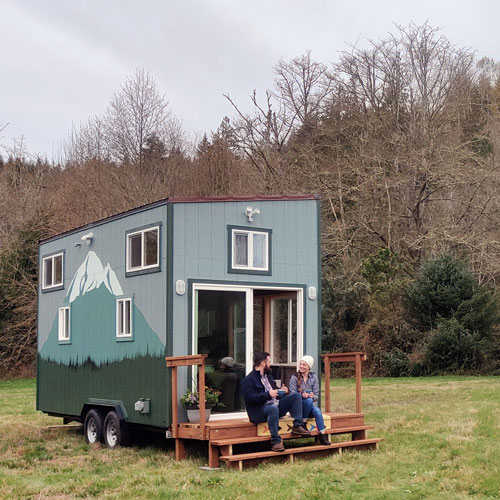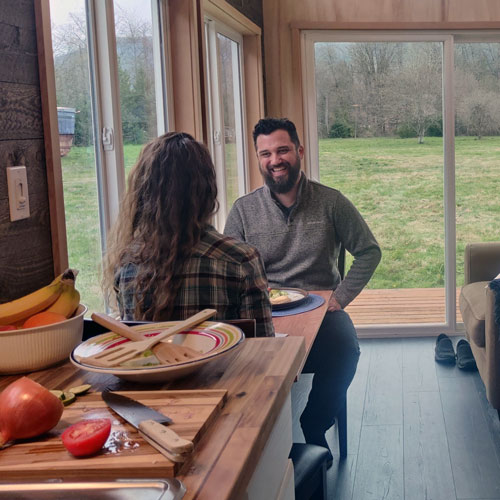Tiny Homes as RVs
Washington State is a dream destination for those seeking simple, sustainable living close to nature. But one of the biggest questions people ask before investing in a Tiny Home on Wheels (THOW) is: Where can I legally park it? Before exploring this, remember that the ultimate authority will always be your local planning and building departments. So be sure to reach out to them for the definitive answers. But here we can explore a few important concepts that will help you discuss the issues and ask the right questions.
Most tiny homes on wheels are built to the RV code. In this case, they are essentially RVs and whatever applies to RVs typically applies to these tiny homes. If you are looking to live in a tiny home that was built to the RV code, your top no hassle options are: RV parks and tiny home villages. Many RV parks allow tiny homes, but, again, they have to be built to the RV code. Most Washington cities have strict laws governing overnight stays in RVs, so just pulling up a tiny home only your friend’s driveway and settling in for the long term isn’t a great idea if you want to follow local laws. (Many people do live in tiny homes illegally. Take a look at Unauthorized Tiny Home Living if you are interested in that topic).
Having said that, some jurisdictions, typically unincorporated areas, do allow extended stays in RVs and RV tiny homes. For example, Snohomish and Skagit counties allow RV occupancy for 180 days out of the year. But cities tend to be more strict. Seattle doesn’t allow any overnight stays in RVs within the city limits. Spokane only allows 14 days of occupancy a year. If you wanted to get creative, and you had a friend couple friends in rural areas, you might be able to switch between them every six months.
So there are some good options for living in a tiny home built to the RV code. But it also feels a bit lacking. Fortunately, there is another possible pathway to tiny home living in Washington.
Washington State’s definition of “Tiny House”
Separate from the RV tiny home, Washington state has its own definition of a tiny home: a dwelling that may be on wheels and is not larger than 400 sq ft. These tiny houses (the term is explicitly tiny house) are built to the Washington State Residential Building Code, which is based on the International Residential Code (IRC).
Most tiny homes are built with residential materials anyway, even if they are built to the RV code. They typically use 2×4 studs, OSB sheathing, residential roofing, and insulation and finishes that you can buy at any building supply store. This means that a tiny home RV is on average much stronger and much more durable than a regular RV. Because if this, changing from the RV code to residential code is not a radical move. There are really just a couple differences: a Washington State tiny house built to the residential code has to meet a higher standard of insulation. And second, the electrical and plumbing must be installed by licensed contractors who specializes in those areas. These two factors do add to the cost of building a Washington State “tiny house” vs an RV tiny home.
While this is a promising pathway to tiny living, it is not the full story. We can’t just build a Washington “tiny house” to the residential code and park it anywhere. This is because local rules and laws also have to be considered. How the tiny home is built is one question. Where its placed is another. Sometimes you have to facilitate this dialog between build and place. Sometimes you need the help of a third party who understands the issues, and that’s where Mount Baker Tiny Homes comes in. Feel free to reach out if you have any questions or trouble navigating this area.
So communication and knowledge are crucial
It’s important to look at your tiny home holistically. What you want to do with a tiny home? Where will you be living?
If you want to live in an RV park or a tiny home village, for example, be sure to talk to the owner or manager to understand their requirements. In a case like this, you probably want to get a tiny home that is built to the RV code.
But perhaps you want your tiny home for an AirBnB rental. Talk to your building department and your planning department. Find out what the rules are and what you can do to make things work.
If you want to buy a city lot and place a tiny home there, check in with that city and see what they require. In some cases, it may not be possible. In other situation, it might work. Tiny home living is still very much a new thing and there are many possible interpretations, conflicts and opportunities for creativity. Curiosity and dialog will be crucial.
And do feel free to contact us if you need any help. He love talking tiny homes.



